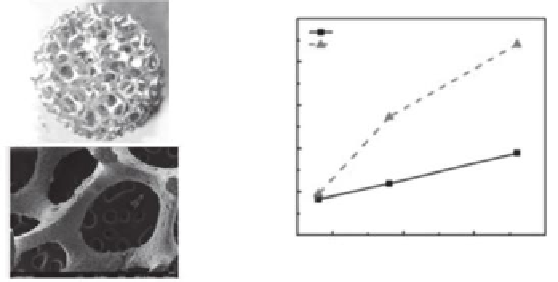Environmental Engineering Reference
In-Depth Information
removed between 97.8% and
100% of the applied bacteria;
colloidal silver treatments
improved ilter performance,
presumably by deactivation
of bacteria. Silver concentra-
tions in efluent ilter water
were initially >0.1 mg/L,
but dropped below this
value after 200 min of con-
tinuous operation. These
results indicate that col-
loidal-silver-impregnated
ceramic ilters, which can be
made using primarily local
materials and labor, show
promise as an effective and
sustainable POU water treatment technology for the world's poorest communities.
73
A mesoporous Ag/Al(OH)
3
nanocomposite ilm on an Al foam ilter capable of rapidly
removing bacterial pathogens from secondary efluent has been reported.
74
The ilter with
A g /A l ( O H )
3
mesoporous nanocomposite ilm showed a good bacterial pathogen removal
rate within a very short contact time of 83 s compared with the untreated Al foam il-
ter (Figure 12.14). Al foam ilters with deposited Ag/Al(OH)
3
mesoporous nanocomposite
ilm can potentially be used as disinfection ilters for tap water puriication or wastewater
treatment.
74
Montmorillonite (MMT)-supported Ag/TiO
2
composite (Ag/TiO
2
/MMT) has been pre-
pared with Ag particles coated with TiO
2
nanoparticles well-dispersed on the surface of
MMT in the composite.
75
Acting as a support for the Ag/TiO
2
composite, the MMT prevents
the loss of the catalyst during recycling test. This Ag/TiO
2
/MMT composite exhibits high
photocatalytic activity and good recycling performance in the degradation of
E. coli
under
visible light. The high visible light photocatalytic activity of the Ag/TiO
2
/MMT compos-
ite is ascribed to the increase in surface-active centers and the localized surface plasmon
effect of the Ag nanoparticles. The Ag/TiO
2
/MMT materials with excellent stability, recy-
clability, and bactericidal activities are promising photocatalysts for application in water
disinfection. Overall, the carbonaceous and mesoporous materials can be the economic
materials that can be used for water disinfection, particularly in developing countries.
75
(a)
(c)
100
Bare Al filter
Ag/Al(OH), film deposited filter
80
60
40
(b)
20
70
75
80
85
Contact time (s)
FIGURE 12.14
Photograph and SEM images of Al foam ilters: (a) Al foam ilter, (b) its
enlarged SEM image and (c)
E. coli
removal rate versus contact time of Al
alloy foam ilter. (From Seo, Y.I. et al.,
J. Hazard. Mater.
, 227-228, 469, 2012.
With permission.)
12.4 Polymer and Polymer-Nanocomposites in
Membrane Filtration Technology
For the past few decades, the use of membrane iltration in drinking-water treatment,
including pathogen removal, has been growing, owing to increasing drinking-water regu-
lations and decreasing costs of purchasing and operating membrane ilters.
8
A semiper-
meable membrane/ilm is used as a selective barrier to remove contaminants from water
in membrane iltration. Most of the contaminants can be removed by membrane processes.
The membrane processes most commonly used to remove microorganism from drinking


